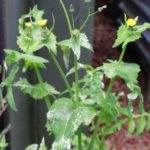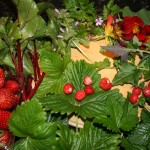Amaranth, Green Amaranthus viridis or Purple Amaranthus lividus
Description
These are summer growing annuals found in disturbed, impoverished places and cultivated nutrient rich places like our vegetable gardens or animal pens. They have densely clustered small green flowers that grow at the terminal or tip of the stem or in the axils of the leaves as seen in the plant to the left which has gone to flower. You can put the whole flower head in your smoothie and get the nutritional benefit of flowers, leaves and seeds. The name Amaranth is Greek for unfading, referring to the flowers that last a long time. The latin names viridis and lividus refers to the stem colour either green or purple (plant to the left). There is another species called Amaranthus powellii which grows much taller up to 1 m high with red stems and longer flower heads. All three Amaranth species I’ve mentioned are also known as Redroot because they all have roots distinctly red roots. Although considered weeds peoples around the world value and use amaranth as leafy vegetables, cereals, ornamentals.
Nutritional properties
Compared to other grains amaranth seeds (below) have a much higher content of the minerals calcium, magnesium, iron and the amino acid lysine. Amaranth seeds are also high in potassium, zinc, Vitamin B and E and protein. Amaranth leaves are loaded with nutrition. For example amaranth leaves contain three times more calcium and three times more niacin (Vitamin B3) than spinach leaves. (Or twenty times more calcium and seven times more iron than lettuce). Amaranth leaves are an excellent source of Vitamin A in the form of antioxidant carotenoids, iron, calcium, protein, Vitamin C Vitamin K, Riboflavin, Vitamin B6, magnesium, phosphorus, potassium, zinc,copper and manganese. Adult purple amaranth plant(below), young plant (below right).
Amaranth leaves are loaded with nutrition. For example amaranth leaves contain three times more calcium and three times more niacin (Vitamin B3) than spinach leaves. (Or twenty times more calcium and seven times more iron than lettuce). Amaranth leaves are an excellent source of Vitamin A in the form of antioxidant carotenoids, iron, calcium, protein, Vitamin C Vitamin K, Riboflavin, Vitamin B6, magnesium, phosphorus, potassium, zinc,copper and manganese. Adult purple amaranth plant(below), young plant (below right).
Recipe
Blueberry Amaranth Smoothie
A bunch of Amaranth
Several stems of Galensoga
2 or more Dandelion leaves
2 Beetroot leaves
small bunch of lemon balm
1.5-2 cups of water
1 banana
1 kiwi fruit
1 peeled tangelo
1 cup blueberries
1 T chia and a sprinkling of pumpkin seeds ground in coffee grinder with either 2 cardamon pods or 2 whole star anise
Blend the greens in the water until well broken down.
Add the fruit and ground chia/pumkin seed, spice mix and blend again.
Pour into a glass and add a few blueberries so that when you drink your smoothie you get some whole blueberries to chew.
Enjoy!









Im obliged for the article.Really thank you! Great.
This showed up in my chicken coop probably from their feed altho it’s not listed in the ingredents. Just discovered your site looking to identify weeds and hap hap happy I did. Think I an going to start my own weed garden alto they seem to be doing fine by themselves. The pursalane is taking over everything but that’s not a bad thing eh. If got a couple that I am having a hard time identifying but I shall preserver. O and herb Robert does very well in my yard as well.